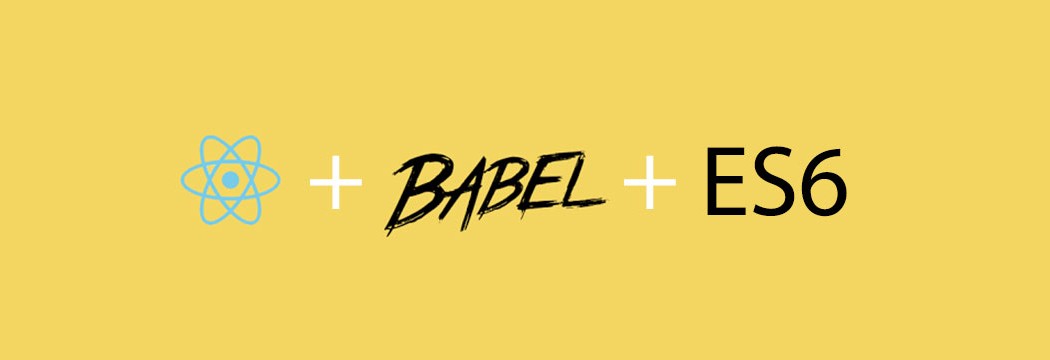一看就懂的 React ES5、ES6+ 常見用法對照表

前言
React 是 Facebook 推出的開源 JavaScript Library。自從 React 正式開源後,React 生態系開始蓬勃發展。事實上,透過學習 React 生態系(ecosystem)的過程中,可以讓我們順便學習現代化 Web 開發的重要觀念(例如:ES6、Webpack、Babel、模組化等),成為更好的開發者。雖然 ES6(ECMAScript2015)、ES7 是未來趨勢(本文將 ES6、ES7 稱為 ES6+),然而目前在網路上有許多的學習資源仍是以 ES5 為主,導致讀者在學習上遇到一些坑洞和迷惑(本文假設讀者對於 React 已經有些基本認識,若你對於 React 尚不熟悉,建議先行閱讀官方文件和本篇入門教學)。因此本文希望透過整理在 React 中 ES5、ES6+ 常見用法對照表,讓讀者們可以在實現功能時(尤其在 React Native)可以更清楚兩者的差異,無痛轉移到 ES6+。
大綱
- Modules
- Classes
- Method definition
- Property initializers
- State
- Arrow functions
- Dynamic property names & template strings
- Destructuring & spread attributes
- Mixins
- Default Parameters
1. Modules
隨著 Web 技術的進展,模組化開發已經成為一個重要課題。關於 JavaScript 模組化我們這邊不詳述,建議讀者參考 這份投影片 和 這篇文章。
ES5 若使用 CommonJS 標準,一般使用 require() 用法引入模組:
1 | var React = require('react'); |
輸出則是使用 module.exports:
1 | module.exports = MyComponent; |
ES6+ import 用法:
1 | import React from 'react'; |
輸出則是使用 export default:
1 | export default class MyComponent extends React.Compoent { |
2. Classes
在 React 中元件(Component)是組成視覺頁面的基礎。在 ES5 中我們使用 React.createClass() 來建立 Component,而在 ES6+ 則是用 Classes 繼承 React.Component 來建立 Component。若是有寫過 Java 等物件導向語言(OOP)的讀者應該對於這種寫法比較不陌生,不過要注意的是 JavaScript 仍是原型繼承類型的物件導向程式語言,只是使用 Classes 讓物件導向使用上更加直觀。對於選擇 class 使用上還有疑惑的讀者建議可以閱讀 React.createClass versus extends React.Component 這篇文章。
ES5 React.createClass() 用法:
1 | var Photo = React.createClass({ |
ES6+ class 用法:
1 | class Photo extends React.Component { |
在 ES5 我們會在 componentWillMount 生命週期定義希望在 render 前執行,且只會執行一次的任務:
1 | var Photo = React.createClass({ |
在 ES6+ 則是定義在 constructor 建構子中:
1 | class Photo extends React.Component { |
3. Method definition
在 ES6 中我們使用 Method 可以忽略 function 和 ,,使用上更為簡潔!ES5 React.createClass() 用法:
1 | var Photo = React.createClass({ |
ES6+ class 用法:
1 | class Photo extends React.Component { |
4. Property initializers
Component 屬性值是資料傳遞重要的元素,在 ES5 中我們使用 propTypes 和 getDefaultProps 來定義屬性(props)的預設值和型別:
1 | var Todo = React.createClass({ |
在 ES6+ 中我們則是參考 ES7 property initializers 使用 class 中的靜態屬性(static properties)來定義:
1 | class Todo extends React.Component { |
ES6+ 另外一種寫法,可以留意一下,主要是看各團隊喜好和規範,選擇合適的方式:
1 | class Todo extends React.Component { |
5. State
在 React 中 Props 和 State 是資料流傳遞的重要元素,不同的是 state 可更動,可以去執行一些運算。在 ES5 中我們使用 getInitialState 去初始化 state:
1 | var Todo = React.createClass({ |
在 ES6+ 中我們初始化 state 有兩種寫法:
1 | class Todo extends React.Component { |
另外一種寫法,使用在建構式初始化。比較推薦使用這種方式,方便做一些運算:
1 | class Todo extends React.Component { |
6. Arrow functions
在講 Arrow functions 之前,我們先聊聊在 React 中 this 和它所代表的 context。在 ES5 中,我們使用 React.createClass() 來建立 Component,而在 React.createClass() 下,預設幫你綁定好 method 的 this,你毋須自行綁定。所以你可以看到像是下面的例子,callback function handleButtonClick 中的 this 是指到 component 的實例(instance),而非觸發事件的物件:
1 | var TodoBtn = React.createClass({ |
然而自動綁定這種方式反而會讓人容易誤解,所以在 ES6+ 推薦使用 bind 綁定 this 或使用 Arrow functions(它會绑定當前 scope 的 this context)兩種方式,你可以參考下面例子:
1 | class TodoBtn extends React.Component |
Arrow functions 雖然一開始看起來有點怪異,但其實觀念很簡單:一個簡化的函數。函數基本上就是參數(不一定要有參數)、表達式、回傳值(也可能是回傳 undefined):
1 | // Arrow functions 的一些例子 |
不過要注意的是無論是 bind 或是 Arrow functions,每次執行回傳都是指到一個新的函數,若需要再調用到這個函數,請記得先把它存起來:
錯誤用法:
1 | class TodoBtn extends React.Component{ |
正確用法:
1 | class TodoBtn extends React.Component{ |
更多 Arrows and Lexical This 特性可以參考這個文件。
7. Dynamic property names & template strings
以前在 ES5 我們要動態設定屬性名稱時,往往需要多寫幾行程式碼才能達到目標:
1 | var Todo = React.createClass({ |
但在 ES6+中,透過 enhancements to object literals 和 template strings 可以輕鬆完成動態設定屬性名稱的任務:
1 | class Todo extends React.Component { |
Template Strings 是一種語法糖(syntactic sugar),方便我們組織字串(這邊也用上 let、const 變數和常數宣告的方式,和 var 的 function scope 不同的是它們是屬於 block scope,亦即生存域存在於 {} 間):
1 | // Interpolate variable bindings |
8. Destructuring & spread attributes
在 React 的 Component 中,父元件利用 props 來傳遞資料到子元件是常見作法,然而我們有時會希望只傳遞部分資料,此時 ES6+ 中的 Destructuring 和 JSX 的 Spread Attributes
,... Spread Attributes 主要是用來迭代物件:
1 | class Todo extends React.Component { |
但使用上要注意的是若是有重複的屬性值則以後來覆蓋,下面的例子中若 ...this.props,有 className,則被後來的 main 所覆蓋:
1 | <div {...this.props} className="main"> |
而 Destructuring 也可以用在簡化 Module 的引入上,這邊我們先用 ES5 中引入方式來看:
1 | var React = require('react-native'); |
以下 ES5 寫法:
1 | var React = require('react-native'); |
在 ES6+ 則可以直接使用 Destructuring 這種簡化方式來引入模組中的元件:
1 | // 這邊等於上面的寫法 |
更進一步可以使用 import 語法:
1 | import React, { |
9. Mixins
在 ES5 中,我們可以使用 Mixins 的方式去讓不同的 Component 共用相似的功能,重用我們的程式碼:
1 | var PureRenderMixin = require('react-addons-pure-render-mixin'); |
但由於官方不打算在 ES6+ 中繼續推行 Mixins,若還是希望使用,可以參考看看第三方套件或是這個文件的用法。
10. Default Parameters
以前 ES5 我們函數要使用預設值需要這樣使用:
1 | var link = function (height, color) { |
現在 ES6+ 的函數可以支援預設值,讓程式碼更為簡潔:
1 | var link = function(height = 50, color = 'red') { |
總結
以上就是 React ES5、ES6+常見用法對照表,能看到這邊的你應該已經對於 React ES5、ES6 使用上有些認識,先給自己一些掌聲吧!確實從 ES6 開始,JavaScript 和以前我們看到的 JavaScript 有些不同,增加了許多新的特性,有些讀者甚至會很懷疑說這真的是 JavaScript 嗎?ES6 的用法對於初學者來說可能會需要寫一點時間吸收,下面我幫大家準備了延伸閱讀,方便大家進一步參考學習。接下來我們也會有一系列從零開始學 React 的文章來帶大家由淺入深學習 ReactJS 生態系,運用 JavaScript 打造跨平台應用程式。筆者才書學淺,若有疏漏歡迎大家一起交流討論:)
延伸閱讀
- React/React Native 的ES5 ES6写法对照表
- React on ES6+
- react native 中es6语法解析
- Learn ES2015
- ECMAScript 6入门
- React官方網站
- React INTRO TO REACT.JS
- React.createClass versus extends React.Component
- react-native-coding-style
- Airbnb React/JSX Style Guide
- 從零開始學 React(ReactJS 101)
關於作者:
@kdchang 文藝型開發者,夢想是做出人們想用的產品和辦一所心目中理想的學校,目前專注在 Mobile 和 IoT 應用開發。A Starter & Maker. JavaScript, Python & Arduino/Android lover.:)

留言討論